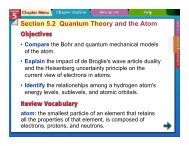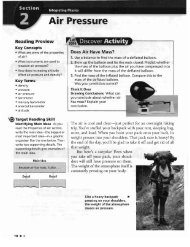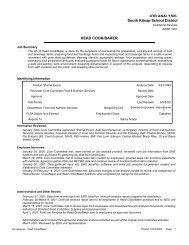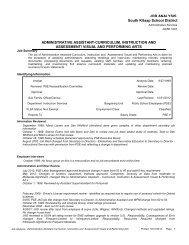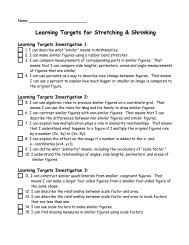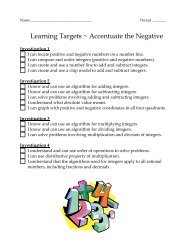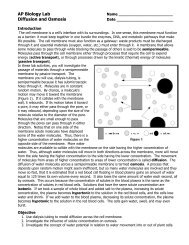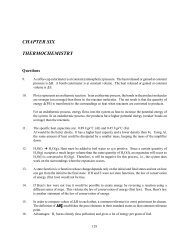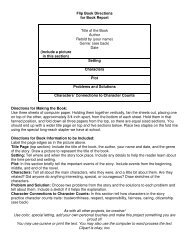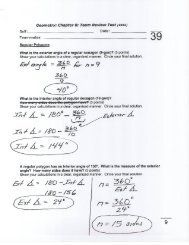6.1 & 6.2 Notes
6.1 & 6.2 Notes
6.1 & 6.2 Notes
You also want an ePaper? Increase the reach of your titles
YUMPU automatically turns print PDFs into web optimized ePapers that Google loves.
Section <strong>6.1</strong> Development of the Modern<br />
Periodic Table<br />
• Trace the development of the periodic table.<br />
• Identify key features of the periodic table.<br />
atomic number: the number of protons in an atom<br />
The periodic table evolved over<br />
time as scientists discovered more<br />
useful ways to compare and<br />
organize the elements.
Section <strong>6.1</strong> Development of the Modern<br />
Periodic Table (cont.)<br />
periodic law<br />
group<br />
period<br />
representative elements<br />
transition elements<br />
metal<br />
alkali metals<br />
alkaline earth metals<br />
transition metal<br />
inner transition metal<br />
lanthanide series<br />
actinide series<br />
nonmetals<br />
halogen<br />
noble gas<br />
metalloid
Development of the Periodic Table<br />
• In the 1700s, Lavoisier compiled a list of all<br />
the known elements of the time.
Development of the Periodic Table (cont.)<br />
• The 1800s brought large amounts of<br />
information and scientists needed a way to<br />
organize knowledge about elements.<br />
• John Newlands proposed an arrangement<br />
where elements were ordered by increasing<br />
atomic mass.
Development of the Periodic Table (cont.)<br />
• Newlands noticed<br />
when the elements<br />
were arranged by<br />
increasing atomic<br />
mass, their<br />
properties repeated<br />
every eighth<br />
element.
Development of the Periodic Table (cont.)<br />
• Meyer and Mendeleev both demonstrated<br />
a connection between atomic mass and<br />
elemental properties.<br />
• Moseley rearranged the table by increasing<br />
atomic number, and resulted in a clear<br />
periodic pattern.<br />
• Periodic repetition of chemical and physical<br />
properties of the elements when they are<br />
arranged by increasing atomic number is<br />
called periodic law.<br />
•http://www.teachersdomain.org/asset/nvhe_vid_periodic/
Development of the Periodic Table (cont.)<br />
Pg 176
The Modern Periodic Table<br />
• The modern periodic table contains boxes<br />
which contain the element's name, symbol,<br />
atomic number, and atomic mass.
The Modern Periodic Table (cont.)<br />
• Columns of elements are called groups.<br />
• Rows of elements are called periods.<br />
• Elements in groups 1,2, and 13-18 possess a<br />
wide variety of chemical and physical<br />
properties and are called the representative<br />
elements.<br />
• Elements in groups 3-12 are known as the<br />
transition metals.
The Modern Periodic Table (cont.)<br />
• Elements are classified as metals,<br />
non-metals, and metalloids.<br />
• Metals are elements that are generally shiny<br />
when smooth and clean, solid at room<br />
temperature, and good conductors of heat<br />
and electricity.<br />
• Alkali metals are all the elements in group 1<br />
except hydrogen, and are very reactive.<br />
•https://www.youtube.com/watch?v=eCk0lYB_8c0<br />
• Alkaline earth metals are in group 2, and<br />
are also highly reactive.
The Modern Periodic Table (cont.)<br />
• The transition elements are divided into<br />
transition metals and inner transition<br />
metals.<br />
• The two sets of inner transition metals are<br />
called the lanthanide series and actinide<br />
series and are located at the bottom of the<br />
periodic table.
The Modern Periodic Table (cont.)<br />
• Non-metals are elements that are<br />
generally gases or brittle, dull-looking<br />
solids, and poor conductors of heat and<br />
electricity.<br />
• Group 17 is composed of highly reactive<br />
elements called halogens.<br />
• Group 18 gases are extremely unreactive and<br />
commonly called noble gases.
The Modern Periodic Table (cont.)<br />
• Metalloids have physical and chemical<br />
properties of both metals and non-metals,<br />
such as silicon and germanium.
The Modern Periodic Table (cont.)
Section <strong>6.1</strong> Assessment<br />
What is a row of elements on the periodic<br />
table called?<br />
A. octave<br />
B. period<br />
C. group<br />
D. transition<br />
A<br />
B<br />
A. A<br />
B. B<br />
C. C<br />
0% 0% 0% 0%<br />
D. D<br />
C<br />
D
Section <strong>6.1</strong> Assessment<br />
What is silicon an example of?<br />
A. metal<br />
B. non-metal<br />
C. inner transition metal<br />
D. metalloid<br />
A<br />
B<br />
A. A<br />
B. B<br />
C. C<br />
0% 0% 0% 0%<br />
D. D<br />
C<br />
D
Section <strong>6.2</strong> Classification of the Elements<br />
• Explain why elements in<br />
the same group have<br />
similar properties.<br />
• Identify the four blocks<br />
of the periodic table<br />
based on their electron<br />
configuration.<br />
valence electron:<br />
electron in an atom's<br />
outermost orbitals;<br />
determines the chemical<br />
properties of an atom<br />
Elements are organized into different<br />
blocks in the periodic table according<br />
to their electron configurations.
Organizing the Elements by Electron<br />
Configuration<br />
• Recall electrons in the highest principal<br />
energy level are called valence electrons.<br />
• All group 1 elements have one valence<br />
electron.
Organizing the Elements by Electron<br />
Configuration (cont.)<br />
• The energy level of an element’s valence<br />
electrons indicates the period on the<br />
periodic table in which it is found.<br />
• The number of valence electrons for<br />
elements in groups 13-18 is ten less than<br />
their group number.
Organizing the Elements by Electron<br />
Configuration (cont.)
The s-, p-, d-, and f-Block Elements<br />
• The shape of the periodic table becomes<br />
clear if it is divided into blocks representing<br />
the atom’s energy sublevel being filled with<br />
valence electrons.
The s-, p-, d-, and f-Block Elements (cont.)<br />
• s-block elements consist of group 1 and 2,<br />
and the element helium.<br />
• Group 1 elements have a partially filled s<br />
orbital with one electron.<br />
• Group 2 elements have a completely filled s<br />
orbital with two electrons.
The s-, p-, d-, and f-Block Elements (cont.)<br />
• After the s-orbital is filled, valence<br />
electrons occupy the p-orbital.<br />
• Groups 13-18 contain elements with<br />
completely or partially filled p orbitals.
The s-, p-, d-, and f-Block Elements (cont.)<br />
• The d-block contains the transition metals<br />
and is the largest block.<br />
• There are exceptions, but d-block elements<br />
usually have filled outermost s orbital, and<br />
filled or partially filled d orbital.<br />
• The five d orbitals can hold 10 electrons, so<br />
the d-block spans ten groups on the periodic<br />
table.
The s-, p-, d-, and f-Block Elements (cont.)<br />
• The f-block contains the inner transition<br />
metals.<br />
• f-block elements have filled or partially filled<br />
outermost s orbitals and filled or partially filled<br />
4f and 5f orbitals.<br />
• The 7 f orbitals hold 14 electrons, and the<br />
inner transition metals span 14 groups.
Section <strong>6.2</strong> Assessment<br />
Which of the following is NOT one of the<br />
elemental blocks of the periodic table?<br />
A. s-block<br />
B. d-block<br />
C. g-block<br />
D. f-block<br />
A<br />
B<br />
A. A<br />
B. B<br />
C. C<br />
0% 0% 0% 0%<br />
D. D<br />
C<br />
D
Section <strong>6.2</strong> Assessment<br />
Which block spans 14 elemental groups?<br />
A. s-block<br />
B. p-block<br />
C. f-block<br />
D. g-block<br />
A<br />
B<br />
A. A<br />
B. B<br />
C. C<br />
0% 0% 0% 0%<br />
D. D<br />
C<br />
D
• <strong>6.1</strong><br />
• #1, 3-5 p. 181<br />
• Ch Assessment #26, 29-32 & 38<br />
p. 198<br />
• <strong>6.2</strong><br />
• #11-14 p. 186<br />
• Ch Assessment #42, 43, 45-48,<br />
54-56 p. 198-199<br />
• #79 p. 200<br />
<strong>6.2</strong> & <strong>6.2</strong> HW



